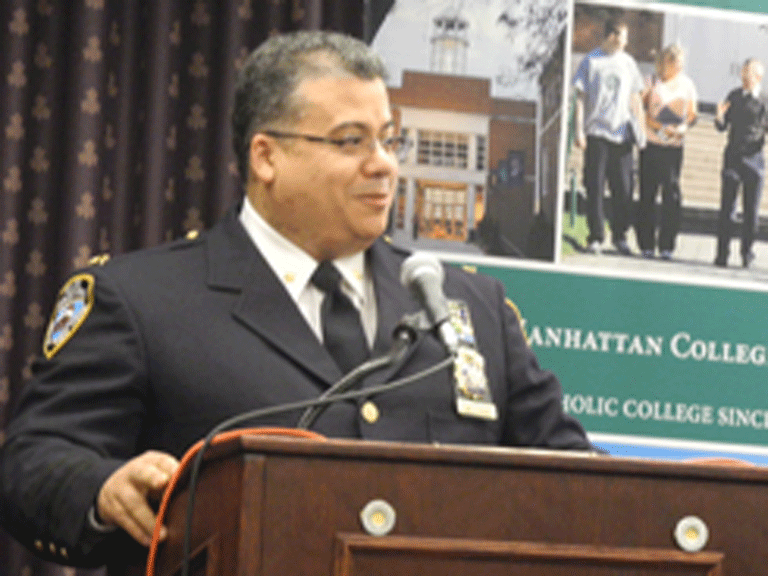 On April 9, Manhattan College engineering students and alumni got a sneak-peek of the latest crime-busting science coming out of the NYPD during a lecture presented by Deputy Chief Ruben Beltran, the department’s executive officer for information technology.
On April 9, Manhattan College engineering students and alumni got a sneak-peek of the latest crime-busting science coming out of the NYPD during a lecture presented by Deputy Chief Ruben Beltran, the department’s executive officer for information technology.
Standing in front of a screen that projected a series of technical graphs and flowcharts, the brawny, bespectacled Beltran joked, “I feel more comfortable giving this presentation to a roomful of engineers.”
Among the newest initiatives discussed during the lecture: the NYPD’s “Mobile Precinct Project,” which relies on the City of New York’s wireless network to transmit data from the NYPD’s Real Time Crime Center to squad car laptops, offering patrol officers up-to-the minute information on every crime scene or domestic disturbance they’re dispatched to. That information might include an alert to any area residents with outstanding warrants or dangerous criminal backgrounds.
The project “allows officers to know the risks awaiting them inside the apartment before they even get there,” said Beltran, noting that the Mobile Precinct Project’s tools will grow to eventually include tablets and smart phones. With the ability to transmit data faster and more cheaply than any radio dispatcher could, the Real Time Crime Center, with its two-dozen analysts tracking hundreds of investigations around the clock, “decentralizes information and makes every detective their own real time-crime center,” Beltran explained.
READ THE NEW YORK DAILY NEWS COVERAGE OF THE MANHATTAN COLLEGE LECTURE HERE.
The event was sponsored by the Manhattan College Latino Alumni Club and the Society of Hispanic Professional Engineers of Manhattan College. Beltran was introduced by Joaquin Prada ’71, the chair of the Latino Alumni Club, who organized the event with the aim of connecting high-ranking NYPD officials and members of the Manhattan College community with Latino heritage. (Seventeen percent of Manhattan College undergraduates identify themselves as Hispanic.)
“I wanted to raise awareness of the presence that Manhattan College has in the Hispanic community, and help it to grow,” said Pradas, who is originally from Spain.
Beltran joined the NYPD in 1986, eventually becoming the first Hispanic commander in his Jackson Heights precinct. He rose through the ranks to become inspector in 2005 and deputy chief in 2008. Law enforcement runs in his blood; his aunt, he said, was the first female detective in Puerto Rico.
Also in attendance were James Onalfo, deputy commissioner of technological development, and a flank of high-ranking NYPD officers, some with Latino backgrounds. Onalfo praised Beltran for possessing an invaluable combination in law enforcement: “he’s an officer who knows policing and understands IT,” Onolfo said.
The students who attended the event left impressed by Beltran’s technological tutorial.
“It showed how the NYPD works through social media to solve the many crimes around the city,” said Denisse Cepeda, president of the Society of Hispanic Professional Engineers of Manhattan College, who was wowed by the department’s use of a Google Maps e-dashboard to keep track of the scores of emergency zones during Superstorm Sandy.
Beltran’s presentation provided an overview of a medley of savvy technical tools like the NYPD’s biometric facial identification software, which relies on specialized algorithms to analyze about 200 facial characteristics of suspects captured on video surveillance. (Apparently, an ear is almost like a fingerprint.) So far the facial recognition technology, which Onalfo said is the envy of the FBI, has led to 120 arrests. Every time a suspect is apprehended via facial recognition technology, Commissioner Raymond W. Kelly ’63 receives a text.
Following Beltran’s presentation, Pradas announced that several audience members, including students, would be invited to tour of the NYPD’s Joint Operations Center at 1 Police Plaza, a newly designed command hub with wall-to-wall high-definition screens and a “situation room,” where high ranking offers tackle emergencies on a day-to-day basis.